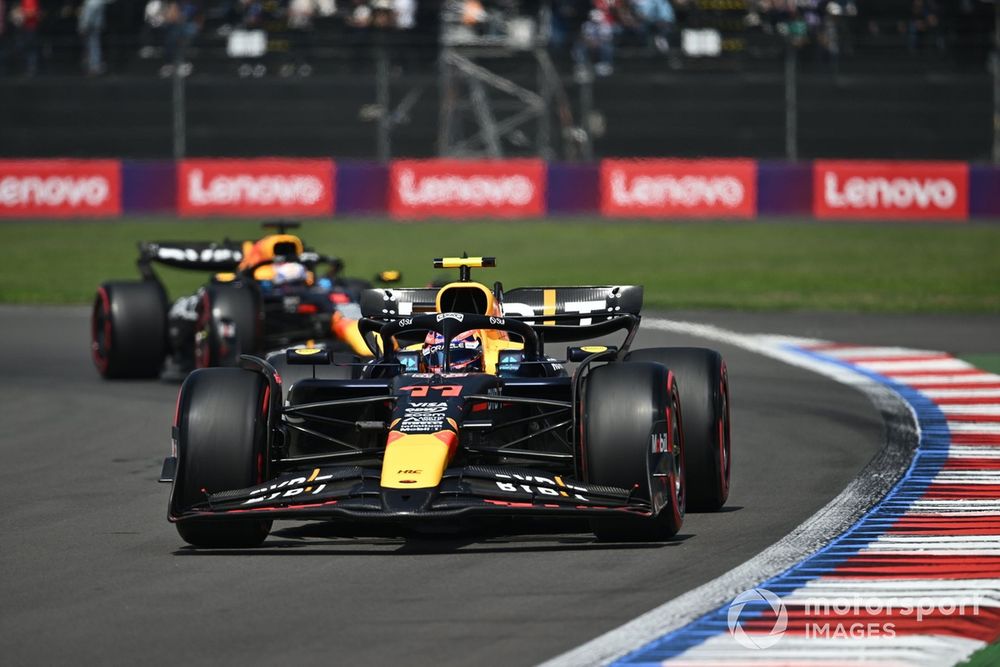The excessive altitude of Mexico’s Autodromo Hermanos Rodriguez Autodromo has all the time been an outlier, with the skinny air impacting downforce decisions in addition to the necessity for further cooling for the facility unit, electronics and brakes.
On this respect, whatever the excessive high speeds being encountered, the automobiles are historically arrange of their most downforce configuration.
Groups usually utilise related entrance and rear wing settings and designs to these often reserved for low-speed circuits, corresponding to Monaco, Hungary and Singapore.
Nevertheless, that pattern was bucked this 12 months, as most of the frontrunners fitted their automobiles with decrease downforce rear wing packages to spice up effectivity and straightline pace.

Some groups break up packages throughout automobiles, with Pink Bull, for instance, having a distinct setup throughout garages. Max Verstappen utilised the decrease downforce association, whereas Sergio Perez used the excessive downforce set-up.
Past the wing decisions, groups have been additionally pressured to make use of their most cooling configurations, with a number of having to carry new bodywork that was opened up considerably compared with different venues.
5 of the ten groups had replace packages at their disposal in Mexico, with all of these that includes some type of extra cooling help.
The remainder of the grid merely re-used the utmost cooling stage bodywork that had been used elsewhere this season, reasonably than help a package deal that may solely make a one-off outing.
The 5 that did go for bespoke packages have been, Pink Bull, McLaren, Ferrari, Williams and RB – all of which had both new, extra expansive cooling louvre configurations and/or enlarged rear cooling shops on the rear of their engine covers.
For each McLaren and Ferrari, the cooling louvres on the facet of their engine covers have been examples of their pre-existing options being taken to extremes, with a lot bigger gills now embossed within the bodywork.

Ferrari SF-24 cooling element, Mexican GP
Photograph by: Giorgio Piola
The SF-24’s answer was not solely extra expansive by way of the rear cooling gills, which stretched down over the engine cowl’s shoulder part into the sidepod’s higher floor.
The workforce additionally determined to mount an extra louvred panel within the ahead part of the sidepod’s higher floor too.
Adjustments have been made to this panel throughout the weekend, with extra cooling gills used throughout FP1/2 (inset), whereas the capability was truly lowered for qualifying and the race.

Ferrari SF-24 cooling
Photograph by: Giorgio Piola
Evaluating this to the association utilized in Monaco, Hungary and Singapore, (left inset, above) we are able to see how way more of the bodywork has been opened as much as enhance warmth rejection.
This leads to the rear cooling outlet remaining the identical dimension, reasonably than having to be expanded, which could, in flip, have extra of an aerodynamic impression on the rear finish of the automotive.
It was the same story for McLaren, because it too opted for a revised cooling louvre panel, which now stretches down over the engine cowl’s shoulder part and reaches throughout the higher floor of the sidepod (Hungarian and Singapore Grand Prix preparations inset, beneath, for comparability).


In the meantime, of the frontrunners, Pink Bull took the other method with its cooling configuration.
The RB20 featured an enlarged rear cooling outlet to assist cope with the extra calls for posed by the altitude, while two louvred panels on both facet of the engine cowl supplemented this additional ahead too.